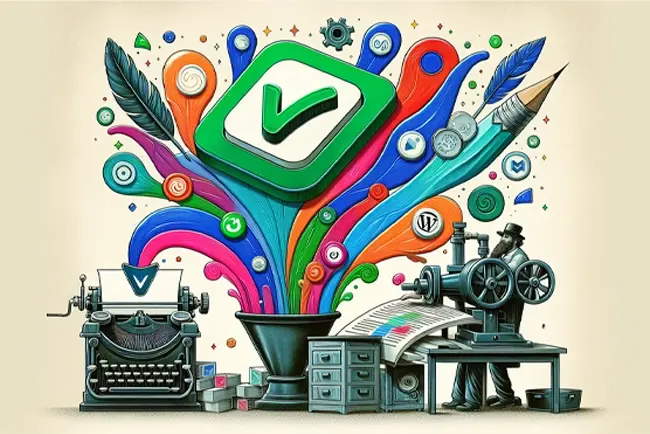
April 29, 2024
15 Essential Inbound Marketing Tools for Success in 2024
Mosaic Blog
Are you maximizing your inbound marketing potential? This article cuts through the noise to deliver an actionable guide on the indispensable inbound marketing tools for 2024. Equip yourself with the knowledge to pick tools that amplify your content, optimize engagement, and drive conversion—essential elements for winning at inbound marketing.
Key Takeaways
- Inbound marketing is essential for modern digital strategy, emphasizing customer engagement through relevant content, and relies on a suite of tools for CRM, content creation, form building, and analytics to optimize initiatives.
- A diverse range of tools are necessary for content creation, social media management, enhancing SEO strategies, crafting visuals, improving user experience, and personalizing marketing campaigns to effectively attract and convert leads.
- Emerging inbound marketing trends for 2024 include the preference for short-form video content, ungated content strategies, interactive guides, and advanced AI and chatbot integrations for enhanced user interaction and support.
The Importance of Inbound Marketing in Today’s Digital Landscape
Inbound marketing has transformed the traditional marketing paradigm by focusing on attracting customers through relevant and helpful content, in contrast to outbound marketing strategies. As businesses strive to establish genuine connections with their audience, inbound marketing emerges as the cornerstone of successful customer engagement. It significantly raises brand awareness, enhances visibility, and fosters greater trust, all while aligning with customer needs to create a seamless and personalized experience.
However, tapping into the full potential of inbound marketing can be challenging. It requires a holistic approach that focuses on building long-lasting relationships and deploying varied tactics for comprehensive engagement. This is where inbound marketing tools come into play, acting as the linchpin that holds together effective inbound strategies.
Crafting Your Inbound Strategy with the Right Tools
In the realm of inbound marketing, tools are indispensable rather than optional. Crafting an effective inbound strategy requires a well-curated suite of tools that optimize the marketing stack, covering aspects such as
- Customer relationship management (CRM)
- Content creation
- Form building
- Analytics
Project management tools like ClickUp and Asana stand out, offering task tracking, collaboration features, and marketing-specific functionalities. Meanwhile, integration platforms like Zapier take automation to the next level, streamlining repetitive tasks and creating more efficient workflows.
With Canva making graphic design easier and Chili Piper enhancing the lead routing process, choosing the appropriate tools is like piecing together the perfect arsenal for conquering the field of inbound marketing.
Elevating Content Creation: Key Tools for Marketers
Content plays a pivotal role in inbound marketing, serving as the magnetic force that attracts users and facilitates their journey through the consideration, purchase, and retention stages.
We’ll explore some vital tools that can enrich the content creation process, making it more efficient and impactful
Streamlining Social Media Management
In our digitally-connected society, social media serves as a potent platform for inbound marketing, offering a direct avenue for interacting with potential customers. This is where social media management tools come into the picture, helping marketers plan and automate social media activity for optimal results.
Buffer, for instance, facilitates the automatic scheduling of posts and planning of inbound marketing campaigns in advance. Hootsuite, on the other hand, allows for the management of multiple profiles on different social media platforms from a single dashboard, streamlining the engagement process with the audience. Add to this the critical role of social media performance tracking, and you have a comprehensive solution to steer your social media marketing in the right direction.
Enhancing SEO Strategy for Organic Traffic
SEO is the silent powerhouse of inbound marketing, operating behind the scenes to boost a website’s visibility in search engine results and propel organic traffic. Tools like Semrush and Ahrefs are instrumental in realizing this goal.
Semrush offers comprehensive keyword research capabilities for search engines, providing related keywords, data on search volume, and competitiveness. To leverage these insights, content must be optimized using tools like Yoast SEO for WordPress and Surfer’s content analysis for enhanced SEO performance.
Moreover, Ahrefs specializes in backlink analysis, which is vital for monitoring and growing online authority and understanding competitors’ strategies
Crafting Eye-Catching Visuals with Ease
Visual content is the distinctive element that sets your inbound marketing strategy apart. Tools like Canva and Capcut have revolutionized the creation of eye-catching visual and video marketing content.
Canva provides a vast array of features, including drag-and-drop functionality and a plethora of pre-designed templates, enabling marketers to create custom images and infographics with ease. Recognizing the growing importance of video marketing, Capcut offers advanced features like AI editing and auto-captions, aligning with the requirements of cutting-edge video marketing strategies.
Optimizing User Experience: Tools to Engage and Convert
The path to successful inbound marketing is lined with outstanding user experiences. Some tools that play a pivotal role in enhancing user experience and engaging users are:
- Dashly: Provides features like chatbots to interact with users
- Unbounce: Helps create effective landing pages
- Hotjar: Offers behavioral analytics to understand user behavior
Incorporating the keyword into the text: Utilizing inbound marketing software tools can greatly improve your inbound marketing efforts and help you create a better user experience.
Unbounce and Instapage, for instance, are specialized landing page creators that help craft responsive pages with features like A/B testing and mobile customization. On the other hand, Hotjar offers visual and analytical insights into user behavior, helping marketers understand how users interact with their website and consequently enhance user experience.
Nurturing Leads into Customers: Automation and Personalization
Converting leads into customers lies at the core of inbound marketing. Automation and personalization are the twin engines that drive this transformation, ensuring consistent follow-ups and creating personalized experiences for potential customers.
Segmenting Audiences for Targeted Messaging
Audience segmentation is the cornerstone of targeted messaging, allowing marketers to deliver content that resonates with different customer groups. Some tools that can help with audience segmentation include:
These tools offer features like lead scoring, behavioral segmentation, and automated workflows that enhance the effectiveness of segmentation.
JotForm takes it a step further, facilitating the collection of valuable lead data through user-friendly form building, which supports the creation of targeted segments. The integration of marketing tools enables businesses to access comprehensive customer profiles, aiding in crafting personalized marketing experiences.
Automating Email Workflows for Consistent Follow-Up
Email workflow automation is a powerful tool that ensures consistent follow-ups with leads, a key factor in maintaining engagement and moving leads through the sales funnel efficiently. SureTriggers, for example, streamlines data flows and triggers actions like adding data to a CRM and sending personalized follow-up emails.
Similarly, Sender’s visual automation builder allows marketers to design responsive email campaigns that automate the follow-up process. By saving time and ensuring timely engagement, these tools lead to a more streamlined and effective email marketing strategy.
Analyzing Success: Measuring Inbound Efforts Effectively
Evaluating the success of inbound marketing efforts is vital for ongoing improvement and optimization. Some tools that can help with this are:
- Google Analytics: Provides insights into user behavior and traffic sources
- Hotjar: Offers heatmaps and user recordings to understand how visitors interact with your website
- Redtrack: Tracks and analyzes the effectiveness of your marketing campaigns
Using these tools can aid in the assessment of success and help you make data-driven decisions for your marketing strategy.
Some tools that offer a comprehensive view of campaign performance across diverse channels are:
- Google Analytics, which provides a comprehensive view of audience behavior, traffic sources, user navigation patterns, and real-time website activity
- Redtrack, which ensures proper attribution of marketing efforts
- ActiveCampaign and Sender, which offer reporting on campaign effectiveness
- Hotjar, which provides visual insights into user behavior, enhancing understanding of user interactions
- Meltwater, which offers a holistic view of campaign performance across diverse channels
These tools, along with others, can help you gain valuable insights into your campaign performance.
The Synergy of Sales and Marketing: CRM Integration
The unification of sales and marketing can significantly transform inbound marketing strategies. CRM integration tools like Salesforce, Pardot, and HubSpot align sales and marketing efforts, streamlining processes, and enhancing collaboration.
Salesforce offers features such as lead and contact management, email integration, and sales forecasting. Pardot enhances CRM with marketing automation features, focusing on personalizing the B2B marketing journey. Eloqua offers over 700 integrations for orchestrating personalized marketing strategies, integrating seamlessly with various business operations. HubSpot’s comprehensive suite of tools, including a free CRM and email marketing, caters to the evolving needs of growing businesses.
Leveraging Social Proof: User-Generated Content Tools
User-generated content (UGC) is now the valuable asset in the world of inbound marketing, deemed more credible and relatable than conventional advertising. UGC-based ads receive 400% higher click-through rates, highlighting the incredible potential of this strategy.
User-generated content tools enable businesses to:
- Collect, curate, and showcase content created by their customers across a variety of channels
- Leverage social proof to build trust and credibility
- Enhance their inbound marketing efforts
The Role of AI in Revolutionizing Inbound Marketing
The introduction of artificial intelligence (AI) has drastically changed the inbound marketing field, unleashing a myriad of opportunities. AI-powered tools like Jarvis, now Jasper.ai, are transforming content creation by writing original content for various platforms efficiently and at scale. AI also enhances content marketing by suggesting topics, generating drafts, and ensuring content is fresh and trend-aligned, as seen with tools like StoryLab.ai.
Meanwhile, live chat solutions such as Intercom and Drift, along with AI-first chat functionalities like Warmly, are becoming increasingly human-like, offering improved conversational engagement. Even in the realm of video marketing, AI-powered tools like Vidyo.ai are making waves, allowing marketers to extract short clips from long-form content for repurposing on social media.
Free vs. Paid: Evaluating Inbound Marketing Tools
In the sphere of inbound marketing tools, the debate between free and paid options is ongoing. However, the choice between the two isn’t as black and white as it seems. Some tools that offer both free and paid versions include:
- HubSpot
- SureTriggers
- Yoast
- SEMrush
- FluentCRM
- Asana
- Fluent Forms
These tools cater to a range of business needs.
While HubSpot’s paid plans provide advanced features and workflows as business demands increase, SureTriggers offers a starting plan for as low as $9 per month, with Yoast, SEMrush, FluentCRM, and Fluent Forms offering premium plans. The choice between free and paid tools should be guided by individual business requirements, features, scalability, and cost-effectiveness.
Integrating Platforms for a Cohesive Marketing Process
Integrating diverse marketing tools into a unified process is pivotal in developing a smooth and results-driven inbound marketing approach. Integration platforms like Zapier and Omnisend connect various marketing tools, creating a cohesive marketing process and streamlined workflows.
Zapier, for instance, can connect different applications to automate repetitive tasks in inbound marketing, enhancing efficiency in workflows. Among marketing automation platforms, Omnisend’s platform is noted for its omnichannel functionality, allowing simultaneous use of multiple channels like email, SMS, and social media in one workflow.
Platforms like HubSpot’s Marketing Hub and Pardot also provide comprehensive solutions, integrating various facets of marketing to achieve a cohesive process.
Scaling Up: Tools for Growing Businesses
As businesses expand, their inbound marketing requirements change. Tools like HubSpot, AdEspresso, and Marketo offer scalable solutions that accommodate business growth and expanding marketing tasks.
HubSpot’s paid plans are designed to scale with business growth, providing more advanced features and workflows as the business demands increase. AdEspresso offers automation for managing ad campaigns across multiple platforms, a necessary feature for agencies experiencing growth. Marketo and Drip provide automation capabilities for tasks ranging from digital advertising to personalized email content, supporting larger marketing operations.
Beyond Basics: Advanced Tools for Inbound Marketers
Moving beyond the basics, there exist advanced tools with intricate features for inbound marketers. HubSpot, a top inbound marketing software, includes a variety of automation tools in a user-friendly dashboard to execute comprehensive inbound marketing strategies.
Trello provides an agile project management platform that helps teams keep projects well-organized. Zapier offers automation across different apps, allowing for a more connected, streamlined workflow. For optimizing content marketing and enhancing SEO strategies, Ahrefs delivers advanced backlink checking and site audits. Social media management tools like Sendible and Sprout Social provide sophisticated features for scheduling, monitoring, and curating content.
Staying Ahead: Emerging Trends in Inbound Marketing Tools
The landscape of inbound marketing is ever-changing, and staying on top necessitates monitoring upcoming trends. One such trend is the rise of short-form video content, with platforms like TikTok influencing the preference for bite-sized, easily consumable video clips.
There’s also a growing trend towards ungated content, allowing free access to valuable information without requiring users to fill out forms. Interactive walkthroughs and step-by-step content guides are becoming more popular, helping users understand products or services at their own pace. The use of AI and chatbots is also on the rise, improving user interactions on websites by offering quick access to information, scheduling, and customer support.
Summary
In the dynamic world of inbound marketing, the right tools are your key to success. Whether it’s content creation, social media management, SEO optimization, or automation and personalization, these tools play a pivotal role in crafting a robust inbound marketing strategy. As we move forward, AI advancements, integration platforms, and user-generated content tools will continue to shape the landscape, offering endless possibilities for businesses to attract, engage, and delight customers. So, gear up and embrace these tools to stay ahead in the game, driving your business to new heights in 2024.
Frequently Asked Questions
What is the role of content creation tools in inbound marketing?
Content creation tools play a crucial role in inbound marketing by helping produce high-quality content that attracts and engages users, leading them through the various stages of the customer journey.
How do SEO tools enhance inbound marketing efforts?
SEO tools enhance inbound marketing efforts by improving a website’s visibility in search engine results and driving organic traffic through features like keyword research and backlink checking. This is vital for enhancing SEO strategies and increasing online presence.
What is the importance of audience segmentation in inbound marketing?
Audience segmentation is important in inbound marketing because it allows for personalized content delivery based on the specific interests and behaviors of different customer groups, leading to more targeted and personalized engagement with customers. This helps in delivering more relevant content to the audience.
How do AI-powered tools revolutionize inbound marketing?
AI-powered tools revolutionize inbound marketing by enhancing content creation, chatbot engagement, and video marketing with advanced features such as AI editing and interactive walkthroughs, ultimately improving user interactions and engagement.
What are the emerging trends in inbound marketing tools?
The emerging trends in inbound marketing tools include the rise of short-form video content, preference for ungated content, popularity of interactive walkthroughs, and the use of AI and chatbots. These trends are shaping the future of inbound marketing.








